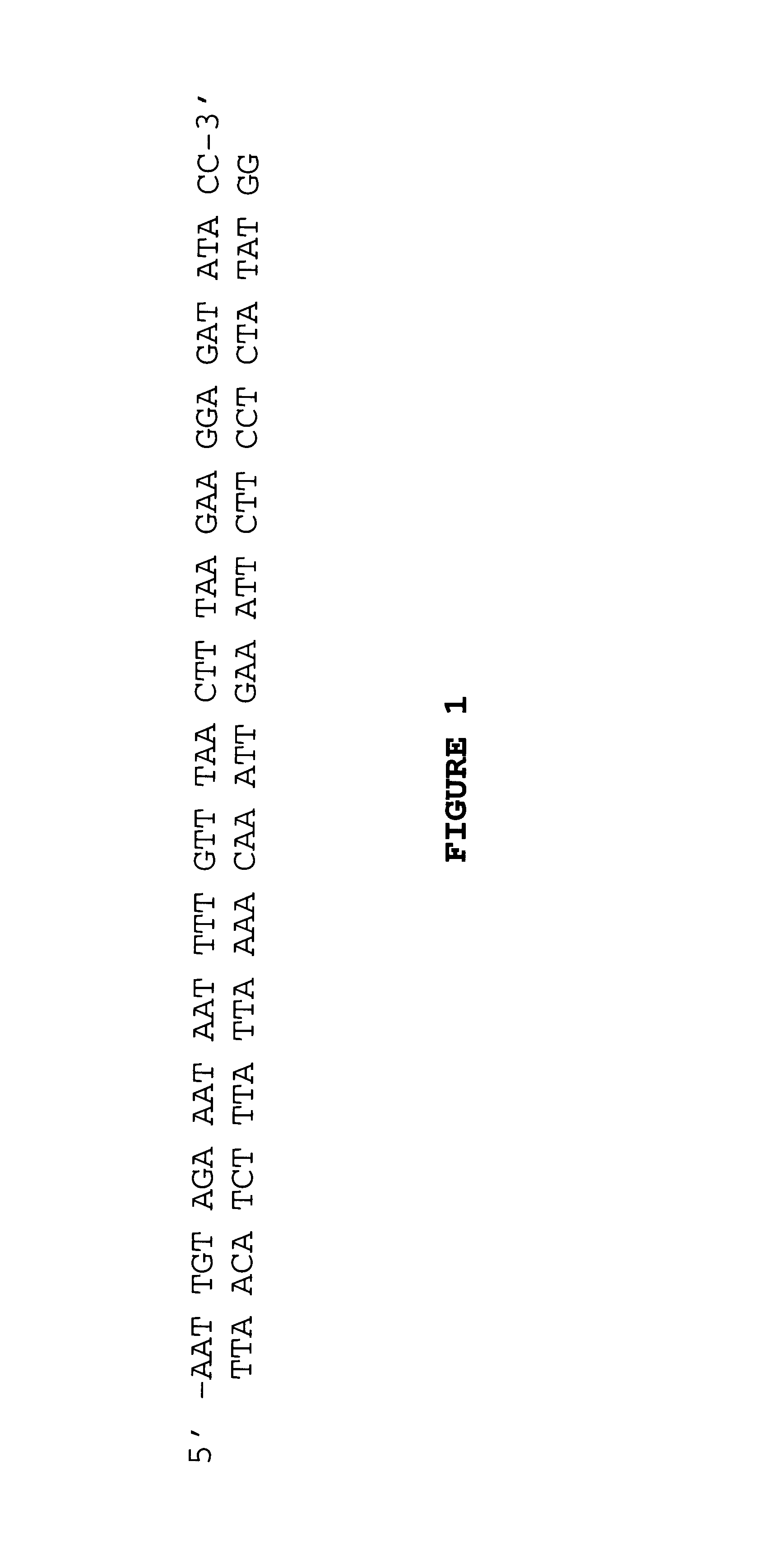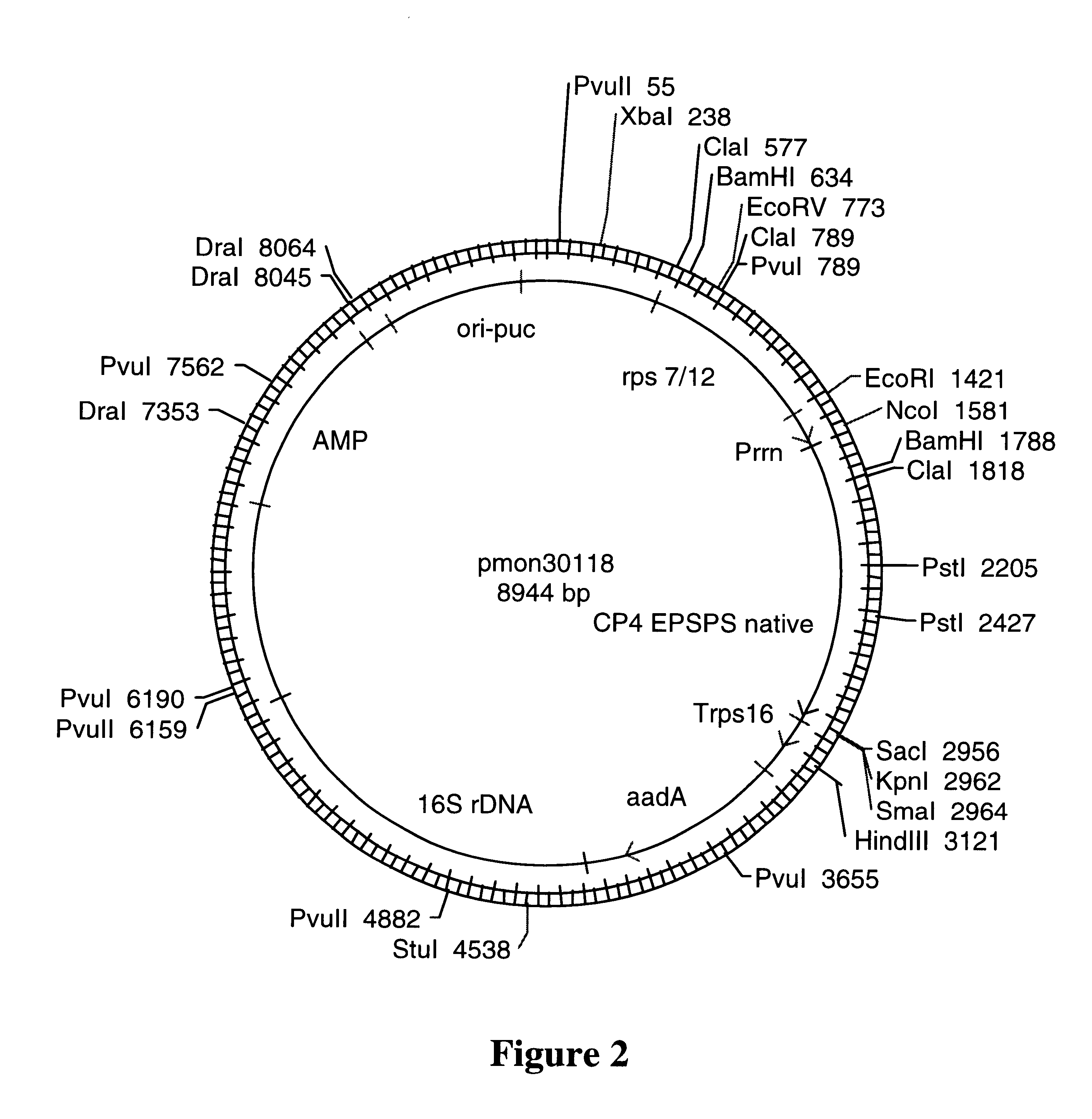Enhancer elements for increased translation in plant plastids
a technology of enhancer elements and plant plastids, which is applied in the field of enhancer elements for increasing the translation of plant plastids, can solve the problems of fundamental differences in the methods used to control gene expression in plastids and prokaryotes, tissue may contain insufficient plastid content for chloroplast transformation,
- Summary
- Abstract
- Description
- Claims
- Application Information
AI Technical Summary
Benefits of technology
Problems solved by technology
Method used
Image
Examples
example 1
Expression Constructs
Constructs and methods for use in transforming the plastids of higher plants are described in Zoubenko et al. (Nuc Acid Res (1994) 22(19):3819-3824), Svab et al. (Proc. Natl. Acad. Sci. (1990) 87:8526-8530 and Proc. Natl. Acad. Sci. (1993) 90:913-917) and Staub et al. (EMBO J. (1993) 12:601-606). Constructs and methods for use in transforming plastids of higher plants to express DNA sequences under the control of a nuclearly encoded, plastid targeted T7 polymerase are described in U.S. Pat. No. 5,576,198. The complete DNA sequences of the plastid genome of tobacco are reported by Shinozaki et al. (EMBO J. (1986) 5:2043-2049). All plastid DNA references in the following description are to the nucleotide number from tobacco.
The complete nucleotide sequence encoding the tobacco cytochrome .function. (.epsilon.tA)is described in Bassham et al, (1991) J Biol Chem 266:23606-23610 and Konishi et al. (1993) Plant Cell Physiol 34:1081-1087.
example 2
Plant Transformation
2A. Nuclear Transformation
Tobacco plants transformed to express the constructs pWRG4744 and pWRG4747 in the nucleus of a plant cell may be obtained as desribed by Horsch et al. (Science (1985) 227:1229-1232).
2B. Plastid Transformation
Tobacco plastids are transformed by particle gun delivery of microprojectiles as described by Svab and Maliga (Proc. Natl. Acad. Sci. (1993) 90:913-917), and described here.
Dark green, round leaves are cut, preferably from the middle of the shoots, from 3-6 week old Nicotiana tabacum cv. Havana which have been maintained in vitro on hormone free MS medium (Murashige and Skoog, (1962) Physiol Plant. 15, 473-497) supplemented with B5 vitamins in Phytatrays or sundae cups with a 16 hour photoperiod at 24.degree. C. Each cut leaf is then placed adaxial side up on sterile filter paper over tobacco shoot regeneration medium (TS0 medium: MS salts, 1 mg / l N.sup.6 -benzyladenine, 0.1 mg / l 1-naphthaleneacetic acid, 1 mg / l thiamine, 100 mg / l in...
example 3
Analysis of Transplastomic Tobacco Plants Transformed with Herbicide Tolerance Constructs
3A. Southern Analysis
Transformed plants selected for marker aadA marker gene expression are analyzed to determine whether the entire plastid content of the plant has been transformed (homoplastic transformants). Typically, following two rounds of shoot formation and spectinomycin selection, approximately 50% of the transgenic plantlets which are analyzed are homoplastic, as determined by Southern blot analysis of plastid DNA. Homoplasmic plantlets are selected for further cultivation.
Genomic DNA is isolated from transformed tobacco plants, electrophoresed, and transferred to filters as described in Svab et al. ((1993), Proc Natl Acad Sci, 90:913-917).
Homoplasmic tobacco plants transformed to express CP4 EPSPS in plastids were identified using a probe prepared from a 2.4 kb EcoRI / EcoRV fragment from the vector pOVZ2 (similar to poVZ15 described in Zoubenko, et al. 1994, supra). The 2.4 kb probe f...
PUM
| Property | Measurement | Unit |
|---|---|---|
| pH | aaaaa | aaaaa |
| pH | aaaaa | aaaaa |
| temperature | aaaaa | aaaaa |
Abstract
Description
Claims
Application Information
 Login to View More
Login to View More - R&D
- Intellectual Property
- Life Sciences
- Materials
- Tech Scout
- Unparalleled Data Quality
- Higher Quality Content
- 60% Fewer Hallucinations
Browse by: Latest US Patents, China's latest patents, Technical Efficacy Thesaurus, Application Domain, Technology Topic, Popular Technical Reports.
© 2025 PatSnap. All rights reserved.Legal|Privacy policy|Modern Slavery Act Transparency Statement|Sitemap|About US| Contact US: help@patsnap.com



